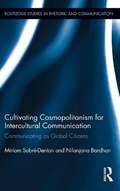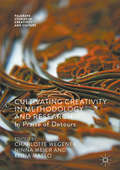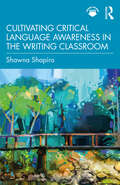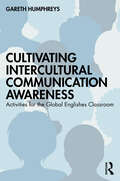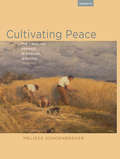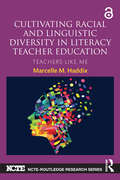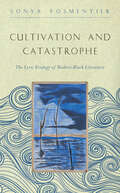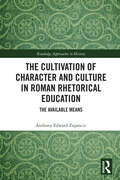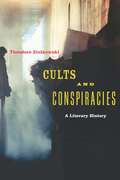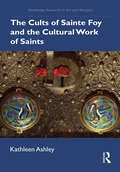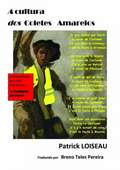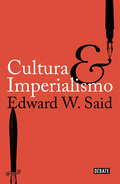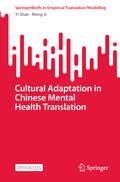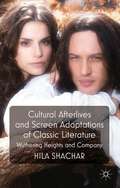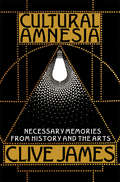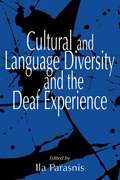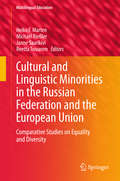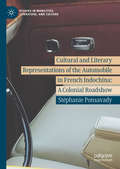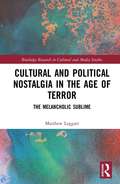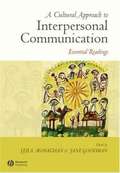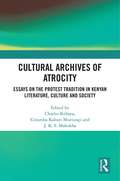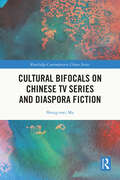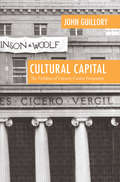- Table View
- List View
Cultivating Cosmopolitanism for Intercultural Communication: Communicating as a Global Citizen (Routledge Studies in Rhetoric and Communication #15)
by Miriam Sobre-Denton Nilanjana BardhanWinner of the National Communication Association's International and Intercultural Communication Division's 2014 Outstanding Authored Book of the Year award This book engages the notion of cosmopolitanism as it applies to intercultural communication, which itself is undergoing a turn in its focus from post-positivistic research towards critical/interpretive and postcolonial perspectives, particularly as globalization informs more of the current and future research in the area. It emphasizes the postcolonial perspective in order to raise critical consciousness about the complexities of intercultural communication in a globalizing world, situating cosmopolitanism—the notion of global citizenship—as a multilayered lens for research. Cosmopolitanism as a theoretical repertoire provides nuanced descriptions of what it means to be and communicate as a global citizen, how to critically study interconnectedness within and across cultures, and how to embrace differences without glossing over them. Moving intercultural communication studies towards the global in complex and nuanced ways, this book highlights crucial links between globalization, transnationalism, postcolonialism, cosmopolitanism, social injustice and intercultural communication, and will help in the creation of classroom spaces devoted to exploring these links. It also engages the links between theory and praxis in order to move towards intercultural communication pedagogy and research that simultaneously celebrates and interrogates issues of cultural difference with the aim of creating continuity rather than chasms. In sum, this book orients intercultural communication scholarship firmly towards the critical and postcolonial, while still allowing the incorporation of traditional intercultural communication concepts, thereby preparing students, scholars, educators and interculturalists to communicate ethically in a world that is simultaneously global and local.
Cultivating Creativity in Methodology and Research: In Praise of Detours (Palgrave Studies in Creativity and Culture)
by Charlotte Wegener Ninna Meier Elina MasloThis book presents a variety of narratives on key elements of academic work, from data analysis, writing practices and engagement with the field. The authors discuss how elements of academic work and life - usually edited out of traditional research papers - can elicit important analytical insight. The book reveals how the unplanned, accidental and even obstructive events that often occur in research life, the 'detours', can potentially glean important results. The authors introduce the process of 'writing-sharing-reading-writing' as a way to expand the playground of research and inspire a culture in which 'accountable' research methodologies involve adventurousness and an element of uncertainty. Written by scholars from a range of different fields, academic levels and geographic locations, this unique book will offer significant insight to those from a range of academic fields.
Cultivating Critical Language Awareness in the Writing Classroom
by Shawna ShapiroThis book introduces Critical Language Awareness (CLA) Pedagogy as a robust and research-grounded framework to engage and support students in critical examinations of language, identity, privilege and power.Starting with an accessible introduction to CLA, chapters cover key topics—including World Englishes, linguistic prejudice, news media literacy, inclusive language practices, and more—in an inviting and thought-provoking way to promote reflection and analysis. Part I provides an overview of the foundations of CLA pedagogy, while Part II highlights four instructional pathways for CLA pedagogy: Sociolinguistics, Critical Academic Literacies, Media/Discourse Analysis, and Communicating Across Difference. Each pathways chapter is structured around Essential Questions and Transferrable Skills, and includes three thematic learning sequences. Part III offers tools and guidance for tailoring CLA pedagogy to the reader’s own teaching context and to students’ individual needs. The volume’s wealth of resources and activities are a pedagogical toolkit for supporting and embracing linguistic diversity in the classroom. The cohesive framework, concrete strategies, engaging activities, and guiding questions in this volume allow readers to come away with not only a deeper understanding of CLA, but also a clear roadmap for implementing CLA pedagogy in the classroom. Synthesizing relevant research from educational linguistics and writing studies, this book is ideal for courses in English/literacy education, college composition, L2 writing instruction, and educational linguistics.
Cultivating Intercultural Communication Awareness: Activities for the Global Englishes Classroom
by Gareth HumphreysIn an increasingly interconnected world, supporting students as they learn to communicate in linguistically diverse intercultural settings is a significant aim of English language and international education. To address this educational objective, this book breaks down the complexities associated with global English in intercultural communication and it challenges conventional educational focuses through activities that promote intercultural awareness and citizenship.The resource book offers pre-service teachers and educators a range of activities grounded in contemporary perspectives on Global Englishes, intercultural learning, and intercultural citizenship education. The book shifts the focus from teaching to imitate native-like proficiency by providing educators with practices and ideas to develop students who are globally aware, can handle complexities of communicating using English as a lingua franca (ELF), and can act as responsible intercultural citizens in a globalised society. Around 120 practical activities are presented for use in supplementing existing curricula or in the design of new learning programmes.This book is a key resource for pre-service teachers and educators involved in English language education, international education, and intercultural education, as well as for scholars and instructors of applied linguistics, TESOL preparation programmes, and teacher education programmes.
Cultivating Peace: The Virgilian Georgic in English, 1650-1750 (Transits: Literature, Thought & Culture 1650-1850)
by Melissa SchoenbergerDuring the decades following the English civil wars, British poets seeking to make sense of lingering political instabilities turned to Virgil’s Georgics. This ancient poem betrays deep ambivalences about war, political power, and empire, and such poets as Andrew Marvell, John Dryden, and Anne Finch found in these attitudes valuable ways of responding to the uncertainties of their own time. Composed during a period of brutal conflict in Rome, Virgil’s agricultural poem distrusts easy stability, urging its readers to understand that lasting peace must be sowed, tended, reaped, and replanted, year after year. Like the ancient poet, who famously depicted a farmer’s scythe suddenly recast as a sword, the poets discussed in Cultivating Peace imagine states of peace and war to be fundamentally and materially linked. In distinct ways, they dismantle the dream of the golden age renewed, proposing instead that peace must be sustained by constant labor. Published by Bucknell University Press. Distributed worldwide by Rutgers University Press.
Cultivating Racial and Linguistic Diversity in Literacy Teacher Education: Teachers Like Me (NCTE-Routledge Research Series)
by Marcelle M. HaddixCultivating Racial and Linguistic Diversity in Literacy Teacher Education examines how English and literacy teacher education—a space dominated by White, English-monolingual, middle class perspectives—shapes the experiences of preservice teachers of color and their construction of a teacher identity. Significant and timely, this book focuses attention on the unique needs and perspectives of racially and linguistically diverse preservice teachers in the field of literacy and English education and offers ways to improve teacher training to better meet the needs of preservice teachers from all racial, ethnic, and linguistic backgrounds. These changes have the potential to diversify the teacher force and cultivate teachers who bring rich racial, cultural, and linguistic histories to the field of teaching.
Cultivating Racial and Linguistic Diversity in Literacy Teacher Education: Teachers Like Me (NCTE-Routledge Research Series)
by Marcelle M. HaddixCultivating Racial and Linguistic Diversity in Literacy Teacher Education examines how English and literacy teacher education—a space dominated by White, English-monolingual, middle class perspectives—shapes the experiences of preservice teachers of color and their construction of a teacher identity.Significant and timely, this book focuses attention on the unique needs and perspectives of racially and linguistically diverse preservice teachers in the field of literacy and English education and offers ways to improve teacher training to better meet the needs of preservice teachers from all racial, ethnic, and linguistic backgrounds. These changes have the potential to diversify the teacher force and cultivate teachers who bring rich racial, cultural, and linguistic histories to the field of teaching.Chapters 1, 2, and 3 of this book are freely available as downloadable Open Access PDFs at http://www.taylorfrancis.com under a Creative Commons Attribution-Non Commercial-No Derivatives (CC-BY-NC-ND) 4.0 license.
Cultivation and Catastrophe: The Lyric Ecology of Modern Black Literature (The <I>Callaloo</I> African Diaspora Series)
by Sonya PosmentierA transformative literary history of black environmental writing.Winner, William Sanders Scarborough Prize by the Modern Language AssociationAt the intersection of social and environmental history there has emerged a rich body of Black literary response to natural and agricultural experiences, whether the legacy of enforced agricultural labor or the destruction and displacement brought about by a hurricane. In Cultivation and Catastrophe, Sonya Posmentier uncovers a vivid diasporic tradition of Black environmental writing that responds to the aftermath of plantation slavery, urbanization, and free and forced migrations. While humanist discourses of African American and postcolonial studies often sustain a line between nature and culture, this book instead emphasizes the relationship between them, offering an innovative environmental history of modern black literature.
The Cultivation of Character and Culture in Roman Rhetorical Education: The Available Means (Routledge Approaches to History)
by Anthony Edward ZupancicAt its very center, The Cultivation of Character and Culture in Roman Rhetorical Education: The Available Means is a study of the subtle, organic ways that rhetoric can work to cultivate a particular character. This is an extension of the current work in composition studies, which focus on the ways that writing instruction contributes to the development of individual power and agency in students, combined with an ancient understanding of the ways that students learned to act within a particular, accepted cultural framework. It recognizes and reclaims a lost dimension of rhetoric, a dimension that is conceptually linked to the martial culture of the ancient world, to show how ancient rhetorical theory framed the discipline as an education in thinking, speaking, and acting in ways that were necessary to be both a persuasive speaker and an effective leader. Through close readings and analysis of particular rhetorical exercises, the book shows how rhetorical education shaped characters that were appropriate in the eyes of the dominant culture but were also capable of working independently to progressively alter that culture. In showing the ways that rhetorical education shaped a particular character, the book demonstrates the ways that the combination character, culture, and virtue are vital to leadership in any time.
Cults and Conspiracies: A Literary History
by Theodore ZiolkowskiExplore 2,000 years of conspiracy in literature.Outstanding Academic Title, ChoiceHuman beings have believed in conspiracies presumably as long as there have been groups of at least three people in which one was convinced that the other two were plotting against him or her. In that sense one might look back as far as Eve and the serpent to find the world’s first conspiracy. Whereas recent generations have tended to find their conspiracies in politics and government, the past often sought its mysteries in religious cults or associations. In ancient Rome, for example, the senate tried to prohibit the cult of Isis lest its euphoric excesses undermine public morality and political stability. And during the Middle Ages, many rulers feared such powerful and mysterious religious orders as the Knights Templar.Fascination with the arcane is a driving force in this comprehensive survey of conspiracy fiction. Theodore Ziolkowski traces the evolution of cults, orders, lodges, secret societies, and conspiracies through various literary manifestations—drama, romance, epic, novel, opera—down to the thrillers of the twenty-first century. Arguing that the lure of the arcane throughout the ages has remained a constant factor of human fascination, Ziolkowski demonstrates that the content of conspiracy has shifted from religion by way of philosophy and social theory to politics. In the process, he reveals, the underlying mythic pattern was gradually co-opted for the subversive ends of conspiracy.Cults and Conspiracies considers Euripides’s Bacchae, Andreae’s Chymical Wedding, Mozart’s The Magic Flute, and Eco’s Foucault’s Pendulum, among other seminal works. Mimicking the genre’s quest-driven narrative arc, the reader searches for the significance of conspiracy fiction and is rewarded with the author’s cogent reflections in the final chapter. After much investigation, Ziolkowski reinforces Umberto Eco’s notion that the most powerful secret, the magnetic center of conspiracy fiction, is in fact "a secret without content."
Cults and Rites in Ancient Greece
by Michael H. Jameson Allaire B. Stallsmith Paul Cartledge Michael H. Jameson Allaire B. StallsmithThis volume assembles fourteen highly influential articles written by Michael H. Jameson over a period of nearly fifty years, edited and updated by the author himself. They represent both the scope and the signature style of Jameson's engagement with the subject of ancient Greek religion. The collection complements the original publications in two ways: firstly, it makes the articles more accessible; and secondly, the volume offers readers a unique opportunity to observe that over almost five decades of scholarship Jameson developed a distinctive method, a signature style, a particular perspective, a way of looking that could perhaps be fittingly called a 'Jamesonian approach' to the study of Greek religion. This approach, recognizable in each article individually, becomes unmistakable through the concentration of papers collected here. The particulars of the Jamesonian approach are insightfully discussed in the five introductory essays written for this volume by leading world authorities on polis religion.
The Cults of Sainte Foy and the Cultural Work of Saints (Routledge Research in Art and Religion)
by Kathleen AshleyBringing together artifacts, texts, and practices within an interpretive framework that stresses the cultural work performed by saints, Kathleen Ashley presents a comparative study of the cults of the medieval Sainte Foy at a number of the sites where she was especially venerated. This book analyzes how each cult site produced the saint it needed, appropriating or creating whatever was required to that end. Ashley’s approach is thoroughly interdisciplinary, incorporating visual, religious, medieval, and women’s and gender studies as well as literary studies and social history. She uses the theoretical framework of "cultural work" to analyze how the cult of Sainte Foy was sponsored and received by specific groups in different locales in Europe. The book is comprehensive in terms of historical as well as geographical range, tracing the history of the cult from the early Middle Ages into the present day. It also includes historiographical analysis, examining the way the cults of Sainte Foy have been represented in various historical accounts. Ashley’s narrative challenges the boundary between "elite" and "popular" culture and complicates the traditional vernacular vs. Latin language binary. A chief aim of the study is to show how "art" objects always operated in conjunction with other cultural texts to construct a saint’s cult. The volume is heavily illustrated, showing artifacts such as stained-glass windows and wall paintings which are not readily available from any other source. This book will be of special interest to scholars in art history, medieval history, gender studies, and religion.
A Cultura dos Coletes Amarelos: Acompanhado por uma referência a A Comuna de Paris
by Patrick Loiseau"Sim, existe uma cultura dos “coletes amarelos”... Quero dizer que esse movimento nascido do inevitável e (portanto) do imprevisível criou seus cânones culturais, apesar de tudo que se possa culpá-lo: o francês esgarçado, os erros de ortografia, a “violência”, a mistura de valores, etc. Ele pode ter ido além do movimento estudantil e, em seguida, da greve geral de maio-junho e 1968. Vou tentar mostrar isto neste livro, por meio de múltiplos desenhos, caricaturas, fotos, logotipos e slogans, etc. Adicionarei os esclarecimentos necessários sobre o contexto social em um clima recorrente de crise política... Esta pintura, que veste o retrato imperfeito e não exaustivo de uma insurreição, não almeja o enciclopedismo, mas apenas trazer justiça a um movimento que tentou quebrar as correntes da pobreza e derrubar, para além do governo autocrático macroniano, uma sociedade egoísta e cada vez mais ditatorial.
Cultura e imperialismo (Colección Argumentos/anagrama Ser. #Vol. 187)
by Edward W. SaidPublicada originalmente en 1993, Cultura e imperialismo es una obra indispensable que restablece el diálogo entre la literatura y la vida, y permite comprender uno de los procesos históricos y culturales más complejos de la modernidad. En el siglo XIX y principios del XX, mientras las grandes potencias se esforzaban en construir y mantener imperios que se extendían desde Australia hasta las islas del Caribe, Occidente fue el protagonista incontestable de un esplendor cultural que vio nacer obras maestras tales como la Aida de Verdi, Mansfield Park de Jane Austen, El corazón de las tinieblas de Conrad o El extranjero de Camus, por citar solo algunas. Con todo, y a pesar de la magnitud del fenómeno imperialista que caracterizó esa época, la mayoría de críticos literarios y culturales nunca prestaron la suficiente atención a su influencia sobre la cultura. Mediante un brillante análisis, Edward W. Said examina estas obras junto con la de escritores de la talla de W. B. Yeats, Chinua Achebe o Salman Rushdie, para demostrar como la periferia sujeta al orden impuesto por la metrópoli supo crear su propia cultura vigorosa, opositora y resistente. Críticas:«Obra imprescindible.»José María Ridao, El País «La originalidad y la eficacia de este estudio se basan en el método. Said trabaja sobre las obras individuales, leyéndolas primero como grandiosos productos de la imaginación creadora e interpretativa, y luego mostrándolas dentro de la relación entre cultura e imperio.»Elvira Huelbes, El Mundo «Pivote entre dos mundos, solo Said ha sido capaz de advertir que la apacible rutina de Mansfield Park, la mansión en la novela de Jane Austen, se mantiene con el trabajo esclavo de una isla del Caribe. Sin imperio, proclama Said, no existiría la novela clásica europea tal como la conocemos.»Terry Eagleton, The Guardian «La crítica literaria que intenta tender puentes entre el arte y la política tiene que aprender mucho, si no todo, de este impresionante diálogo de Said consigo mismo.»Camille Paglia, The Washington Post
Cultural Adaptation in Chinese Mental Health Translation (New Frontiers in Translation Studies)
by Meng Ji Yi ShanThis open access book demonstrates the necessity, feasibility, and effectiveness of cultural adaptation in the translation of mental health scales into Chinese. It illustrates the key principles of culturally effective mental health translation, through offering in-depth discussions of the methods and techniques used to translate mental health materials into Chinese. This SpringerBrief title provides an essential reading for academics, researchers, students from language studies, public health and health communication who are interested to develop more advanced skills of translating and adapting mental health instruments for people from culturally and linguistically diverse backgrounds.
Cultural Afterlives and Screen Adaptations of Classic Literature
by Hila ShacharFilm and television adaptations of classic literature have held a longstanding appeal for audiences, an appeal that this book sets out to examine. With a particular focus on Wuthering Heights , the book examines adaptations made from the 1930s to the twenty-first century, providing an understanding of how they help shape our cultural landscape.
Cultural Amnesia: Necessary Memories From History And The Arts
by Clive James"I can't remember when I've learned as much from something I've read—or laughed as much while doing it." —Jacob Weisberg, Slate This international bestseller is an encyclopedic A-Z masterpiece—the perfect introduction to the very core of Western humanism. Clive James rescues, or occasionally destroys, the careers of many of the greatest thinkers, humanists, musicians, artists, and philosophers of the twentieth century. Soaring to Montaigne-like heights, Cultural Amnesia is precisely the book to burnish these memories of a Western civilization that James fears is nearly lost.
Cultural and Language Diversity and the Deaf Experience
by Ila ParasnisThis edited volume provides a comprehensive analysis of deaf people as a culturally and linguistically distinct minority group within American society. Many educators, linguists, and researchers now favor this position, as opposed to that which states that a deaf person simply has an audiological disability. Contributors to this book include members of the deaf community, as well as prominent deaf and hearing educators and researchers. The text contains three sections, covering research on bilingualism and biculturalism, the impact of cultural and language diversity on the deaf experience, and first-hand accounts from deaf community members that highlight the emotional impact of living in the deaf and hearing worlds.
Cultural and Linguistic Minorities in the Russian Federation and the European Union: Comparative Studies on Equality and Diversity (Multilingual Education #13)
by Reetta Toivanen Janne Saarikivi Heiko F. Marten Michael RießlerThis is the first comprehensive volume to compare the sociolinguistic situations of minorities in Russia and in Western Europe. As such, it provides insight into language policies, the ethnolinguistic vitality and the struggle for reversal of language shift, language revitalization and empowerment of minorities in Russia and the European Union. The volume shows that, even though largely unknown to a broader English-reading audience, the linguistic composition of Russia is by no means less diverse than multilingualism in the EU. It is therefore a valuable introduction into the historical backgrounds and current linguistic, social and legal affairs with regard to Russia's manifold ethnic and linguistic minorities, mirrored on the discussion of recent issues in a number of well-known Western European minority situations.
Cultural and Literary Representations of the Automobile in French Indochina: A Colonial Roadshow (Studies in Mobilities, Literature, and Culture)
by Stéphanie PonsavadyHow are the pleasures and thrills of the automobile linked to France’s history of conquest, colonialism, and exploitation in Southeast Asia? Cultural and Literary Representations of the Automobile in French Indochina addresses the contradictions of the “progress” of French colonialism and their consequences through the lens of the automobile. Stéphanie Ponsavady examines the development of transportation systems in French Indochina at the turn of the twentieth century, analyzing archival material and French and Vietnamese literature to critically assess French colonialism.
Cultural and Political Nostalgia in the Age of Terror: The Melancholic Sublime (Routledge Research in Cultural and Media Studies)
by Matthew LeggattThis book re-examines the role of the sublime across a range of disparate cultural texts, from architecture and art, to literature, digital technology, and film, detailing a worrying trend towards nostalgia and arguing that, although the sublime has the potential to be the most powerful uniting aesthetic force, it currently spreads fear, violence, and retrospection. In exploring contemporary culture, this book touches on the role of architecture to provoke feelings of sublimity, the role of art in the aftermath of destructive events, literature’s establishment of the historical moment as a point of sublime transformation and change, and the place of nostalgia and the returning of past practices in digital culture from gaming to popular cinema.
A Cultural Approach to Interpersonal Communication
by Leila Frances Monaghan Jane E. GoodmanThis reader connects interpersonal communication and culture, primarily but not exclusively through an anthropological, ethnographic lens. Monaghan (interpersonal communication, Indiana U.) and Goodman (communication and culture, Indiana U.) have chosen 42 pieces that generally share a performance-based approach to communication and culture that emphasizes the dynamic and creative role language plays in the construction of social reality. Combining theoretical discussions and ethnographic case studies, the contributions have been organized into three sections that first provide an introduction to cultural, ethnographic, and performance-based approaches to personal communication; explore the use of linguistic meaning, form, and function for social purposes and link language to social identity; place questions of interpersonal communication into the context of social groups; and discuss how interpersonal interactions shape and are shaped by institutional settings. Annotation ©2007 Book News, Inc., Portland, OR (booknews.com)
Cultural Archives of Atrocity: Essays on the Protest Tradition in Kenyan Literature, Culture and Society
by Muriungi Columba Charles Kebaya Makokha Justus Kizito SiboeStudies on the aesthetic representations of atrocity the world over have taken different discursive dimensions from history, sociology, political to human rights. These perspectives are usually geared towards understanding the manifestations, extent, political and economic implications of atrocities. In all these cases, representation has been the singular concern. Cultural Archives of Atrocity: Essays on the Protest Tradition in Kenyan Literature, Culture and Society brings together generic ways of interrogating artistic representations of atrocity in Kenya. Couched on interdisciplinary, multidisciplinary and cross-disciplinary approaches, essays in this volume investigate representations of Atrocity in Kenyan Literature, Film, Popular Music and other mediated cultural art forms. Contributors to this volume not only bring on board multiple and competing perspectives on studying atrocity and how they are archived but provide refreshing and valuable insights in examining the artistic and cultural interpellations of atrocity within the socio-political imaginaries of the Kenyan nation. This volume forms part of the growing critical resources for scholars undertaking studies on atrocity within the fields of ethnic studies, cultural studies, postcolonial studies, peace and conflict, criminology, psychology, political economy and history in Kenya.
Cultural Bifocals on Chinese TV Series and Diaspora Fiction (ISSN)
by Sheng-mei MaThe book explores how Chinese TV series and Asian Diaspora fiction are consumed, experienced, and adapted by and for audiences worldwide, particularly those of the Chinese diaspora.It focuses or ‘zooms in’ on well-known exceptional Chinese TV series such as Reset and The Bad Kids and ‘zooms-out’ to explore a wider panorama of lesser-known TV dramas and films. It also explores Asian American representations of ‘bespoke immigrants’, the Nobelist Kazuo Ishiguro and other ‘1.5-generation novelists’, a Canadian missionary’s memoir, a Taiwanese Canadian young adult fantasy author, among others. Through the analysis of this material, it reveals how some Asian American writers are themselves liable to portraying stereotypes of Asian immigrant communities, reinforcing familiar tropes of the white gaze. It also features an insightful analysis of Taiwan’s films and culture, highlighting how Taiwanese identity is represented and moreover shaped by cross-strait tensions.Exploring a diversity of content and media consumption, this book will appeal to students and scholars of media studies, Cultural studies, Chinese studies and Asian studies.
Cultural Capital: The Problem of Literary Canon Formation
by John GuilloryJohn Guillory challenges the most fundamental premises of the canon debate by resituating the problem of canon formation in an entirely new theoretical framework. The result is a book that promises to recast not only the debate about the literary curriculum but also the controversy over "multiculturalism" and the current "crisis of the humanities. " Employing concepts drawn from Pierre Bourdieu's sociology, Guillory argues that canon formation must be understood less as a question of the representation of social groups than as a question of the distribution of "cultural capital" in the schools, which regulate access to literacy, to the practices of reading and writing.
